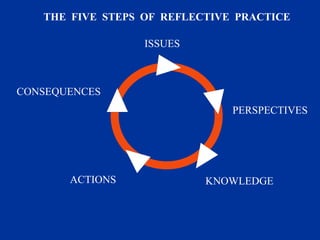
Using Cases
- 1. ISSUES PERSPECTIVES KNOWLEDGE ACTIONS CONSEQUENCES THE FIVE STEPS OF REFLECTIVE PRACTICE
- 2. USING THE FIVE STEPS OF REFLECTIVE PRACTICE 1. ISSUES: Identify issues, problems, dilemmas, and opportunities. 2. PERSPECTIVES: Consider different perspectives or take into account the values underlying individuals’ actions. 3. KNOWLEDGE: Call up professional knowledge from academic preparation, educational theory, and practical experience. 4. ACTIONS: Apply knowledge and skills to make decisions. 5. CONSEQUENCES: Assess the consequences of decisions and outcomes of actions.
- 3. STEP ONE: Identify ISSUES Perceive problems & opportunities Focus on “acute” or “ underlying” issues
- 4. STEP TWO: Recognize PERSPECTIVES 1. VALUES 2. FEELINGS 3. SPECIAL KNOWLEDGE OF SITUATION
- 5. STEP THREE: KNOWLEDGE 1. PERSONAL/PRACTICAL EXPERIENCE 2. THEORY/RESEARCH 3. “WANT TO KNOW” ? 4. FACTS FROM THE CASE
- 6. STEP FOUR: ACTION 1. SHORT TERM 2. LONG TERM
- 7. STEP FIVE: CONSEQUENCES CONSIDER OUTCOMES OF ACTIONS
